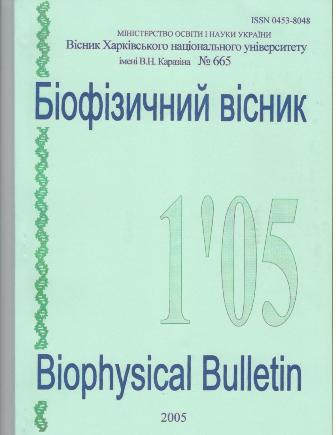Complex of GroEL chaperone with fluorescein-labeled denatured pepsin: stoichiometry and role of the ligands
Abstract
One of the main functions of the molecular chaperone GroEL (tetradecameric protein from E.coli cells) is the binding of polypeptides with nonrigid packed side chains and prevention of their nonspecific aggregation. In the present work the interaction of GroEL with fluorescein-labeled nonnative pepsin (pH 7.5) in the absence and in the presence of GroEL various ligands (Mg2+ ions, ADP, ATP and heptameric co-chaperone GroES) has been studied using size exclusion chromatography and fluorescence anisotropy titration. It was shown that Mg2+ ions play determinant role in the formation of the complex between GroEL and nonnative pepsin at moderate ionic strength (100 mM KCl). In the presence of Mg2+ ions adenyl nucleotides (ADP or ATP) decrease the GroEL affinity to nonnative pepsin in the dependence on nucleotide nature, concentration and presence of co-chaperone GroES. Fluorescence anisotropy titration showed that in the presence of Mg2+ ions one GroEL molecule binds two molecules of denatured pepsin with average dissociation constant Kdiss=3.6 •10-9M.
Downloads
References
2. Gething M. J. and Sambrook J. //Nature. 1992. 355. P. 33-45.
3. Martin J., Langer T., Boteva R. et al. //Nature 1991. 352. P. 36-42.
4. Viitanen P.V., Gatenby A.A. and Lorimer G.H. // Protein Sci. 1992. J. P. 363-369.
5. Lindquist S. and Craig E.A. ///Annu. Rev. Genet. 1988. 22. P. 631-677.
6. Christman M.F., Morgan R.W., Jacobson F.S. et al. //Cell. 1985. 41. P. 753-762.
7. Schlesinger M. J. // J. Biol. Chem. 1990. 265. P. 12111-12114.
8. Fenton W.A. and Horwich A.L. // Protein Sci. 1997. 6. P. 743-760.
9. Hayer-Hartl M.K., Ewbank J. J., Creighton T.E. et al. // EMBO J. 1994.13.P. 3192-3202.
10. Lin Z., Schwartz F.P. and Eisenstein E.//J. Biol. Chem. 1995.270 P. 1011-1014.
11. Viitanen P.V., Lubben T.H., Reed J. et al. // Biochemistry. 1990. 29. P. 5665-5671.
12.Katsumata K., Okazaki A., Tsurupa G.P. et al. // J. Mol. Biol. 1996. 264. P. 643-649.
13.Todd M .I., Viitanen P.V. and Lorimer G.H. // Science. 1994. 265. P. 659-666.
14. Marchenko N.Yu., Marchenkov V.V., Kotova N.V. et al. //Ukr. Biokhim. Zh. 2003. 75.
P. 88-94.
15. Goloubinoff P., Christeller J.T., Gatenby A.A. et al. //Nature. 1989. 342. P. 884-889.
16. Chen J., Walter S., Horwich A.L. et al. // Nat. Struct. Biol. 2001.8. P. 721-728.
17. Aoki K., Taguchi H., Shindo Y et al. // J. Biol. Chem. 1997. 272. P. 32158-32162.
18.Lissin N.M., Venyaminov S.Y. and Girshovich A.S. //Nature. 1990. 348. P. 339-342.
19. Laemmli U.K //Nature. 1970. 227. P. 680-685.
20. Lakowicz J.R. Principles of fluorescence spectroscopy. Kluwer Academic / Plenum Publishers, New York. 1999.
21. Schulz G.E., Schirmer R.H. Principles of protein structure. Springer-Verlag, New York - Heidelberg - Berlin:, 1979.
22. Pack C.G., Nishimura G., Tamura M. et al. // Cytometry. 1999. 36. P. 247-253.
23. Hayer-Hartl M K., Martin J. and Hartl F.U. // Science. 1995. 269. P. 836-841.
Authors who publish with this journal agree to the following terms:
- Authors retain copyright and grant the journal right of first publication with the work simultaneously licensed under a Creative Commons Attribution License that allows others to share the work with an acknowledgement of the work's authorship and initial publication in this journal.
- Authors are able to enter into separate, additional contractual arrangements for the non-exclusive distribution of the journal's published version of the work (e.g., post it to an institutional repository or publish it in a book), with an acknowledgement of its initial publication in this journal.
- Authors are permitted and encouraged to post their work online (e.g., in institutional repositories or on their website) prior to and during the submission process, as it can lead to productive exchanges, as well as earlier and greater citation of published work (See The Effect of Open Access).





